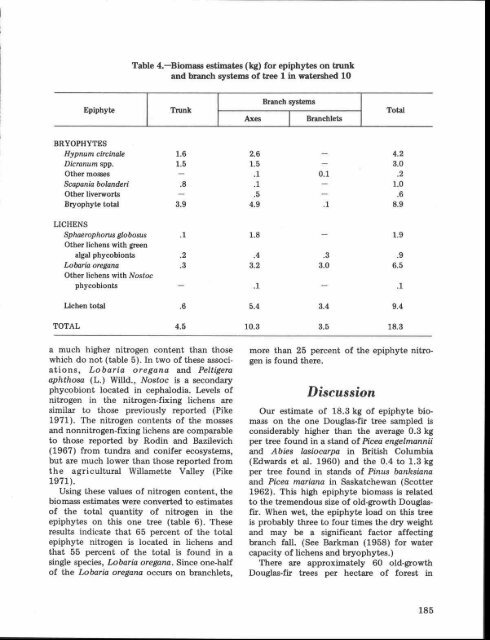PE EIE[R-Rg RESEARCH ON - HJ Andrews Experimental Forest
PE EIE[R-Rg RESEARCH ON - HJ Andrews Experimental Forest
PE EIE[R-Rg RESEARCH ON - HJ Andrews Experimental Forest
Create successful ePaper yourself
Turn your PDF publications into a flip-book with our unique Google optimized e-Paper software.
Table 4.-Biomass estimates (kg) for epiphytes on trun k<br />
and branch systems of tree 1 in watershed 1 0<br />
Branch system s<br />
Epiphyte Trunk Total<br />
Axes<br />
Branchlets<br />
BRYOPHYTES<br />
Hypnum circinale 1 .6 2 .6 4. 2<br />
Dicranum spp . 1 .5 1 .5 3. 0<br />
Other mosses .1 0 .1 . 2<br />
Scapania bolanderi .8 .1 1 . 0<br />
Other liverworts .5 . 6<br />
Bryophyte total 3 .9 4 .9 .1 8.9<br />
LICHEN S<br />
Sphaerophorus globosus .1 1 .8 1 . 9<br />
Other lichens with green<br />
algal phycobionts .2 .4 .3 . 9<br />
Lobaria oregana .3 3.2 3 .0 6 . 5<br />
Other lichens with Nostoc<br />
phycobionts .1 . 1<br />
Lichen total .6 5 .4 3 .4 9 . 4<br />
TOTAL 4 .5 10 .3 3 .5 18 .3<br />
a much higher nitrogen content than thos e<br />
which do not (table 5). In two of these associations,<br />
Lobaria oregana and Peltigera<br />
aphthosa (L.) Willd ., Nostoc is a secondary<br />
phycobiont located in cephalodia. Levels of<br />
nitrogen in the nitrogen-fixing lichens are<br />
similar to those previously reported (Pike<br />
1971). The nitrogen contents of the mosse s<br />
and nonnitrogen-fixing lichens are comparabl e<br />
to those reported by Rodin and Bazilevic h<br />
(1967) from tundra and conifer ecosystems ,<br />
but are much lower than those reported fro m<br />
the agricultural Willamette Valley (Pik e<br />
1971) .<br />
Using these values of nitrogen content, th e<br />
biomass estimates were converted to estimate s<br />
of the total quantity of nitrogen in th e<br />
epiphytes on this one tree (table 6). Thes e<br />
results indicate that 65 percent of the tota l<br />
epiphyte nitrogen is located in lichens an d<br />
that 55 percent of the total is found in a<br />
single species, Lobaria oregana . Since one-half<br />
of the Lobaria oregana occurs on branchlets,<br />
more than 25 percent of the epiphyte nitrogen<br />
is found there .<br />
Discussion<br />
Our estimate of 18.3 kg of epiphyte biomass<br />
on the one Douglas-fir tree sampled i s<br />
considerably higher than the average 0 .3 kg<br />
per tree found in a stand of Picea engelmannii<br />
and Abies lasiocarpa in British Columbi a<br />
(Edwards et al. 1960) and the 0 .4 to 1 .3 k g<br />
per tree found in stands of Pinus banksiana<br />
and Picea mariana in Saskatchewan (Scotter<br />
1962) . This high epiphyte biomass is relate d<br />
to the tremendous size of old-growth Douglasfir.<br />
When wet, the epiphyte load on this tree<br />
is probably three to four times the dry weight<br />
and may be a significant factor affectin g<br />
branch fall. (See Barkman (1958) for wate r<br />
capacity of lichens and bryophytes . )<br />
There are approximately 60 old-growt h<br />
Douglas-fir trees per hectare of forest in<br />
18 5








